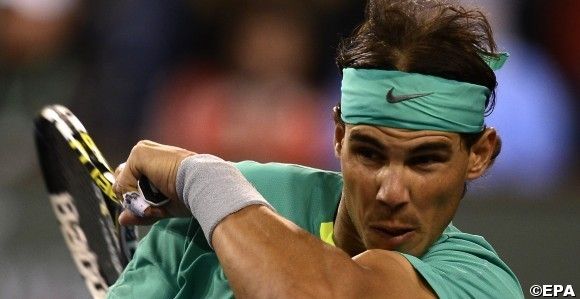Rafael Nadal Attacks Time Violation Enforcement; Meeting Ahead
THE ATP Players Council will meet in Miami next week and will discuss the enforcement of the 25-second time violations rule. A number of players have objected to it, saying that umpires need to be more flexible, even though the Player Council did unanimously pass the rule at the 2012 US Open with the support of the majority of players. Apparently there are some players who are now complaining that various umpires don’t call the rule consistently enough.
“I think it’s a good rule,” said Player Council rep Kevin Anderson, “I think it’s always tough you have to sometimes take into consideration, extenuating circumstances. If you play like an incredibly long point or the ball kids ‑‑ maybe the ball goes out or something. Just from the standpoint I think it’s a good rule. It makes it fair for everybody. But I have hear as the year has gone on, some guys are saying it’s getting a bit more lax. There aren’t as many time violations going on out there. I just heard a couple guys saying with different matches some people are sticking to the rule and some people aren’t. It’s a work in progress, so hopefully after Miami we will be able to sort of assess where it’s at and see what other people are feeling. I mean, just have to go from there.”
Not only have Tomas Berdych and Gael Monfils come out strongly against the rule, but Rafael Nadal also gave it the once over at Indian Wells.
The Spaniard has the reputation for being one of the tour’s slowest players, but he doesn’t believe that most fans mind.
“Somebody very smart puts a new rule that is a disaster, in my opinion. Not in places like [Indian Wells] that is dry, not very humid place, but is completely disaster when we are playing in tournaments like Acapulco, Brazil, or Chile. The rule is wrong. First thing, because the rules go against the great points of tennis. Because if you see the highlights of the end of the season, I didn’t see not one highlight, the best points of the season, I did not see not one ace. The best points of the season are long rallies and amazing points. With this 25 seconds, you play a long rally and you think you can play another long rally next point? No. So go against the good tennis.”
Nadal also mentioned that by speeding up play that TV channels will have hard time running commercials.
The rule begins with warning and then after that for the second and all subsequent violations, the penalty is a fault for the server and a point penalty for the receiver.
Nadal, who has won 11 Grand Slam titles, said that during his time off he went back and reviewed some of his previous matches and time himself. He discovered that he was taking more time in between points after marathon rallies.
However, the Grand Slams and the ATP have different rules: the majors use a 20-second between points time rule, but allow the umpires to be flexible.
That’s the way Nadal would like it to be.
“You have to see the third set of the US Open 2011 against Djokovic, and you tell me if the crowd was very happy about what happened in that set or not, and tell me if with this new rule that can happen again,” Nadal said. “Please.”
Nadal was bold enough to mention that with the rule being strictly enforced, and because almost every court he and the other top players play on use the Hawk-eye line calling review technology, that the umpires have very little to do.
“We can play without referee 100%,” he said. “The lines on every line, Hawk-Eye, now 25 seconds. He don’t have to analyze nothing. He just have to put the clock and that’s it. Then we can play. Put the clock on court and play without umpire, because it’s not necessary anymore because the umpire is not enough good to analyze if the match is being hard, if somebody is losing time, penalize him with a warning.”
©Daily Tennis News Wire
Topics: ATP Players Council, Gael Monfils, Kevin Anderson, Miami tennis news, Rafael Nadal, tennis time limitations, Tomas Berdych


10sBalls Top Stories
- Reasons Behind the Increase in Sex Shops
- Reasons Behind the Increase in Sex Shops
- Reasons Behind the Increase in Sex Shops
- Casibom: Yaşayan Casinolar ve Bahisler Lider Platform
- Sea Star Casino: Play Games Without Registering Online
- JETZT DEN SWEET BONANZA SLOT GRATIS DREHEN
- Азартные игры с Мостбет Казино – испытайте удачу
- Çevrimiçi en iyi yuvalar: Hizmetinizde Karavan Bet Casino
- Top No Deposit Free Spins Offer for Canadians – December 2024
- Abe Bet Casino: Ücretsiz dönüşlerle heyecan hissedin
- Ünlü slotlar çevrimiçi kumarhanelerde başarı bet giriş ücretli formatta
- BasariBet Casino Giriş – En Güzel Canlı Casino Oyunlarına Katılın
- Игра на деньги в казино 1вин казино: безопасность
- De parking de credits sans oublier les Diction Casino Archive sauf que Perception
- Играть в хитовые слоты в надежных клубах azino777





 Rafael Nadal Attacks Time Violation Enforcement; Meeting Ahead
Rafael Nadal Attacks Time Violation Enforcement; Meeting Ahead